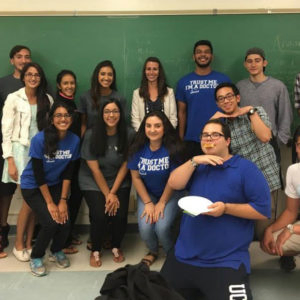Sample MCAT Biochemistry Question
In terms of the proton gradient created during the oxidative phosphorylation, which of the following is true?
a) Low [H+] in the intermembrane space; High [H+] in the mitochondrial matrix
b) Low [H+] in the intermembrane space; Low [H+] in the mitochondrial matrix
c) Low [H+] in the mitochondrial matrix; High [H+] in the intermembrane space
d) High [H+] in the intermembrane space; High [H+] in the mitochondrial matrix
Oxidative Phosphorylation and ATP Production
Recall that oxidative phosphorylation, the process of oxidizing NADH and FADH2 to power ATP, has two steps. The first step is the electron transport chain, where NADH and FADH2 are oxidized to produce a proton gradient. The second step involves ATP synthase, an enzyme which utilizes something called proton motive force to produce ATP. This post discusses the latter step.
Chemiosmotic Coupling and Proton Motive Force
In order to understand how ATP is produced by ATP synthase, it’s important to first understand the concept of chemiosmotic coupling. Chemiosmotic coupling is the idea that the proton concentration gradient across the inner mitochondrial membrane, which is generated by the electron transport chain, is ultimately what drives ATP production via ATP synthase.
We discussed the electron transport chain and the creation of the proton gradient in a previous post. However, just to refresh your memory, recall that in the electron transport chain, enzyme complexes oxidize electron carriers like NADH and FADH2 and couple this reaction with the pumping of protons from the mitochondrial matrix to the intermembrane space. This pumping of protons creates a high proton concentration in the intermembrane space and a low proton concentration in the mitochondrial matrix, and this proton gradient acts as a store of energy. The energy stored in the proton concentration difference is also called the proton motive force. This proton motive force is what will be used to produce ATP. (Figure 1).
The reason why proton motive force can power so much ATP production is because it is a store of both chemical potential energy and electrical potential energy. The chemical potential energy is due to the concentration difference across the membrane (recall that chemicals naturally flow from a higher concentration to a lower concentration) (Figure 1) and the electrical potential energy refers to the charge difference between the mitochondrial matrix and the intermembrane space. By pumping positive charges into the intermembrane space, the mitochondrial matrix carries a net negative charge in comparison to the intermembrane space. In this way, the mitochondrial matrix will be able to attract positive charges as a result of stored up electrical potential energy, motivating protons to move back into the matrix.

Figure 1. Proton Motive Force
Proton Motive Force and ATP Synthesis
The formation of ATP from ADP and inorganic phosphate is an energetically unfavorable reaction. By coupling ATP synthesis with an electrochemical gradient, an energetically unfavorable, endergonic reaction is paired with an energetically favorable, exergonic one. Figure 2 illustrates a special protein pore in the inner mitochondrial membrane called ATP synthase. The function of ATP synthase is to couple the favorable movement of protons down their concentration gradient with the unfavorable synthesis of new ATP molecules. This is what chemiosmotic coupling is.

Figure 2. ATP Synthesis via Chemiosmotic Coupling and Proton Motive Force
Explore More
MCAT Masterclass Chapters
Take a closer look at our entire MCAT Masterclass or explore our lessons below.
-
Electron Transport Chain
View Subject -
Composition by Percent Mass
View Subject -
Conciousness-Altering Drugs- MCAT Psychology
View Subject -
Glycolysis Net Reaction
View Subject -
Mole Concept, Avogadro’s Number, and Molecular Weight
View Subject -
Proactive vs Retroactive Interference - MCAT Psychology
View Subject




